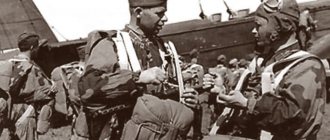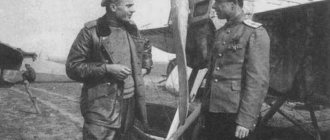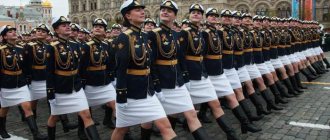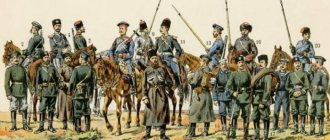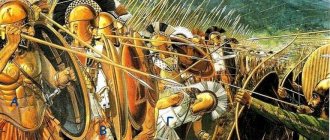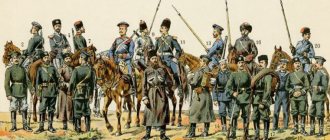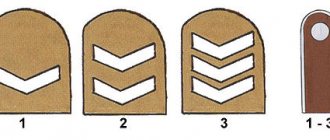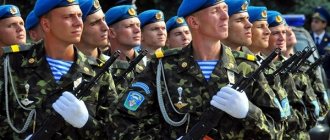Airborne troops are designed to land behind enemy lines and then carry out combat and sabotage missions. It is known that paratroopers are called differently, in accordance with the nature and style of their combat operations: “winged” or “air” infantry, “airmobile troops”, “quick reaction forces”, “commandos”. For military personnel of this type of troops, each state provides special clothing. This article provides information about the Airborne Forces uniform for Russian soldiers.
Where did you serve?
On this issue, real paratroopers identify impostors with a very high probability.
Answers like: “I served in the Pskov division” are not suitable here. A fighter of this illustrious formation should know its full name - the 76th Guards Air Assault Chernigov Red Banner Division. Types of Russian special forces. INFOGRAPHICS A paratrooper must always know the full name of the unit in which he served in the division, with all its regalia. For example, the 234th Guards Air Assault Black Sea Order of Kutuzov Regiment named after the Holy Blessed Alexander Nevsky.
Without hesitation, soldiers must know the battalion, company and platoon where they served. And also remember your commanders. Real airborne veterans don’t forget this.
Airborne special forces
In the USSR, airborne special forces did not officially exist.
However, in 1950, the need arose to create protection against NATO mobile nuclear weapons, and it was then that the first separate companies and battalions of special forces were formed. Only in 1994 did Russia officially announce the creation of special forces. The main tasks of such units:
- conducting reconnaissance;
— carrying out sabotage operations on the territory of the alleged enemy with the destruction of communication facilities and infrastructures;
— capture and retention of strategic objects;
- demoralization and disorientation of enemy troops.
Due to the specificity of their activities, the Airborne Special Forces have more modern equipment, weapons, and equipment. And all this, of course, requires more substantial funding. Special forces soldiers have high moral, psychological, physical and ideological training, which helps them work in special, often extreme, conditions.
Uniform of the Workers' and Peasants' Red and Soviet Army
In 1918, the Red Army was created from the wreckage of the former tsarist troops and all kinds of volunteer detachments. Units appeared that fought for the new, Soviet power. The young republic spared nothing for their uniforms, but in the conditions of the confusion of the internecine war, it was not possible to make a more or less uniform uniform of a new model.
Now non-commissioned officers were called detached commanders, and generals were called corps commanders and brigade commanders. Instead of shoulder straps, sleeve insignia and buttonholes were introduced. With minor changes, they will exist until 1943, although they will be seen here and there at the front until the end of the war.
The problems of supplying the army with uniforms were solved with the help of the royal clothing warehouses. They also found one of the symbols of the Red Army in the Civil War, a unique headdress known as the budenovka. According to the most common version, it was created by the artist Vasnetsov for the Russian Imperial Army during the First World War.
In these headdresses, similar to the helmets of epic heroes, the soldiers had to parade through defeated Berlin. But the parade didn’t work out, but the Soviets happily took the opportunity to dress their supporters. The first name of the hat, hero, was quickly forgotten. In some places Budenovka was known as Frunzevka, in honor of M.V. Frunze, one of the main commanders of the Workers' and Peasants' Red Army.
During the Civil War, there were many signs on the uniform that distinguished the Reds from the Whites. Thus, red flaps, bows and stars were worn on overcoats and tunics. As the fighting ends, the uniform takes on a calmer tone. Only in the 1930s, on the wave of general upsurge and preparation for a new big war, did the Red Army acquire many innovations. The gymnasts have a turn-down collar instead of a stand-up collar.
For each specialty, the edging and color on caps and caps are determined. Instead of caps, caps are being introduced everywhere, designed to be worn together with a helmet. But the color splendor of the Soviet military uniform ends in the summer of 1941. Colored buttonholes turned out to be too good a target and in August 1941 they were changed to khaki buttonholes.
The winter of 1942-43 was marked by the return of shoulder straps to the army. With minimal changes, this system will continue to this day. The Red Army soldier again dons a tunic with a stand-up collar and eyelets for shoulder straps. Experienced fighters, however, will keep their tunics with ripped buttonholes until the end of the war.
The tunics of privates and command personnel differed. Thus, privates did not have pockets on their chests, while officers had two external pockets, protected by a valve, and one internal one.
Tunics will serve until the 1960s. At this time, the Vietnam War will demonstrate the mighty and terrible power of napalm. Since the tunic is removed over the head, it is considered not the best uniform for a possible war. Tunics will replace the “hebe”, a jacket with buttons, known from many photos and films of the 1960s...1980s.
But “hebe” will also be an intermediate option. During the war in Afghanistan, the legendary “Afghan” will appear, a sand-colored uniform adapted for combat operations in any conditions.
What do Russian paratroopers wear today?
By 2014, the uniform of the Russian Airborne Forces had undergone a number of changes. The ears of hats with earflaps have become longer, due to which they can be easily overlapped at the back and fastened using a special Velcro.
In addition, the hats are equipped with a top flap, which can be used as a visor if necessary. Heavy shoes have been replaced with insulated boots equipped with special thermal inserts. The changes also affected outerwear.
In addition to the modern military uniform of the Airborne Forces (photo presented in the article), an insulated vest is included. As the paratroopers testify, it does not at all restrict movement when performing physical exercises. In addition to the vest, the modern uniform kit includes a comfortable balaclava, as well as a scarf-front, with which the paratrooper can cover himself from the wind. Depending on weather conditions, the jacket can transform into a windbreaker or an insulated peacoat.
A set of modern military uniforms for paratroopers consists of several jackets that can be used depending on the time of year. In addition, the following are provided: an appropriate suit, an insulated vest, a beret or hat, a balaclava, three pairs of boots, two pairs of gloves and mittens.
Today, depending on weather conditions, there are three ways to combine airborne uniforms:
- In cool weather, paratroopers wear lined jackets.
- In strong winds, soldiers can pull up sweatshirts under their jackets.
- In the rain, wear fleece shirts and waterproof overalls.
On forced marches, airborne troops wear regular uniforms. Light clothing is required for theoretical classes.
Airborne Forces lapel emblem
The modern military uniform of the Airborne Forces is almost unthinkable without the famous sign - a parachute with two aircraft on both sides. It does not just mean that a serviceman belongs to aviation, it is a real symbol of the unity of paratroopers. The Airborne Forces uniform has been decorated with this lapel insignia since 1955, when the Soviet Army was transitioning to a new uniform and it was decided to develop new insignia for different types and branches of the military. Commander-in-Chief V.F. Margelov A real competition was announced, as a result of which the winning drawing was created by a draftswoman serving in the Soviet Army. This simple, but soulfully created emblem formed the basis for the creation of various airborne symbols and became the main component of award badges and sleeve patches.
First paratrooper uniform
Until the 40s of the last century, the uniform of the airborne detachment differed little from the uniform of the Red Army soldiers serving in the aviation troops. It consisted of a leather or canvas helmet with a soft lining and overalls made of moleskin or avisent. The blue buttonholes sewn to the collar of the overalls indicated that the detachment belonged to aviation.
The edging of the buttonhole indicated the official position of the serviceman: the command staff had a golden edging, while political workers, sergeants and privates wore uniforms with buttonholes with black edging, which was considered an everyday (or as it is now called - office) option. At the beginning of the Great Patriotic War, overalls were replaced by trousers with large patch pockets and a jacket.
The paratrooper's equipment in the pre-war years, in addition to the uniform, consisted of the following elements:
- Main parachute. Before the war of 1941 and for some time after its outbreak, airborne troops used the PD-6 parachute, which is essentially a licensed analogue of the American “Irvin”. Before establishing their own parachute production, the Soviet military performed jumps with American parachutes.
- A reserve parachute, a Finnish knife or a line cutter.
The complete equipment of an Airborne Forces employee was:
- two parachutes (main on the back, reserve in the lower abdomen);
- duffel bag;
- a machine gun with a magazine removed, which was attached vertically with the barrel down behind the left shoulder.
In winter, a large fur collar of dark blue, brown or khaki color was attached to the overalls using buttons or a zipper. When raised, the collar was tightened with internal straps. Often, the style of winter airborne uniforms directly depended on the manufacturer's factory.
After the failed Finnish campaign, the military personnel were dressed in padded jackets, short fur coats, felt boots, cotton trousers, and a hat with earflaps. At the same time, the winter version is equipped with a camouflage white robe with a hood.
Airborne Forces uniform in the USSR
Military clothing of the Airborne Forces was divided into 4 groups:
- summer uniform for every day for sergeants and soldiers;
- summer casual clothing for sergeants, airborne cadets, soldiers;
- summer casual clothing of cadets, where buttonholes and shoulder straps indicated the branch of service;
- winter clothing for sergeants, cadets, military builders, where buttonholes, shoulder straps and a badge on the sleeve are according to the branch of service.
In addition, the military uniform in the USSR had to take into account the climatic features of the area where the troops were located. For example, in the Finnish war, a soldier’s winter clothing was supplemented with:
- hats with earflaps,
- padded jackets,
- cotton pants,
- white camouflage robes and hoods.
The rest of the military clothing in the USSR, for example, for rifle units, looked like a simple budenovka and boots. In addition to their canvas helmets, the paratroopers had large goggles for pilots. This attribute was issued due to the fact that they often had to parachute. If you take a close look at the photo or film materials of those times, you can see that even ceremonial clothing could consist of helmets and glasses, and a parachute jumpsuit.
The military uniform of a USSR officer had a cap with a chin strap for parachute jumping; ordinary Red Army soldiers hid their caps in their bosoms. There were no special shoes for jumping, so felt boots often fell off the feet when the parachute opened. Officer's shoes also presupposed the existence of fur boots.
The usual uniform of the Airborne Forces in Russia differed from other troops only in blue buttonholes; officers had gold trim around them. The piping on the buttonholes of political workers, sergeants or privates was black; this was considered a kind of office option. Officers were also distinguished by blue piping on the collar and the upper edge of the cuffs, and side stitched seams on the riding breeches. Caps with blue piping and red stars or dark blue caps with red enamel stars - all this was typical for the leadership of the Airborne Forces.
During the existence of the Soviet Union, the Ukrainian Airborne Forces were no different in their military uniform from the Russian troops; one single template was in effect throughout the entire USSR. After the collapse of the state, Ukraine had to “redraw” not only the meaning of the type of troops itself, but also the form of intelligence. Until recently, the airborne forces of these two countries could only be distinguished by different stripes, which depicted the coats of arms of different countries. Ukraine's uniform depicts a trident on a yellow-blue background.
All products by tags
Related Products
Trousers from a special suit of parachute parts With buttons The belt is adjustable in size using side elastic bands High waistband for the convenience of carrying ammunition on a belt Belt loops for a wide waist belt Reinforcing lining with a softening insert on the knees (photo A) Mesh for ventilation in the groin area Bottom of the trousers with an elastic band The cuffs at the bottom of the trousers are cinched with tape, which prevents debris from getting into the shoes Pockets: 2 side pockets and 2 hip pockets with a folded top, which prevents items from spontaneously falling out 1 knife pocket 2 back pockets Material: 100% cotton YOU MAY BE INTERESTED IN: Designed for parachute parts of the suit turned out to be very convenient for tourists. Everything that is suitable for a parachute is also good for a backpack. Durable, heavy duty canvas fabric, pre-shrunk and highly fade resistant. The tarpaulin breathes, protects from wind and moisture, is not afraid of a fire (if you do not dry clothes on a fire rope) and is not bitten by insects. The loose-fitting jacket does not restrict movement and has no protruding parts. Due to the absence of lower pockets, it can be worn either untucked or tucked into trousers. Buttons characteristic of uniforms. The bottom of the jacket is adjustable in size. Two front pockets and easy-to-access side sleeve pockets are secured with flaps. The internal pocket for documents is made of water-repellent fabric. Ventilation in the most overheated areas of the jacket and trousers is provided by mesh fabric. The most tense ones (elbows and knees) are reinforced with additional pads (on the knees with a softening insert). Pants with a high, adjustable elastic waistband and straps for a wide belt are comfortable and allow you to carry the necessary equipment on the belt. The loose cut and drawstring bottom of the legs allow you to move freely through the most inaccessible places and protect the boots from debris getting inside. The restraint of the jacket is more than compensated by the abundance of pockets on the trousers. Slit pockets on the sides are simple and familiar, two back pockets with flaps, two front pockets with flaps on the front of the hips and a pocket for a knife. You can place everything you need from salt, matches, maps, compass and GPS to machine gun horns. A durable, comfortable, breathable, unpretentious suit will provide reliable protection in the forest and in the air.
MPA-78 Light jacket provides excellent protection from wind, thanks to the stitched lining, removable hood and windproof strip. On the right and left shelves there are patch pockets fastened with textile fasteners. There are also front side welt pockets with a zipper. The sleeves are adjustable in width using tape and plastic patches (Velcro). Along the shoulder line there are false shoulder straps fastened with buttons. On the left side of the jacket lining there is a horizontal zippered pocket. The demi-season jacket of the Ministry of Defense provides excellent protection from wind thanks to the stitched lining, removable hood and windproof flap. On the right and left shelves there are patch pockets fastened with textile fasteners. Appearance. Jacket of a straight silhouette with an insulated stitched lining, with a central side zipper, with an external wind flap, and a drawstring at the waist. The front has a stitched yoke extending to the back, with upper welt pockets with flaps fastened with textile fasteners, side welt pockets fastened with a zipper. Set-in two-seam sleeves with stitched cuffs on an elastic band and plastic patches (Velcro) at the bottom to adjust the width. Along the shoulder line there are shoulder straps with false shoulder straps, fastened with buttons. Stand collar. The hood is fastened with a zipper, consisting of three parts. The hood along the front neckline is adjustable with an elastic cord and clamps. On the left side of the jacket lining there is a horizontal zippered pocket. Characteristics protection from cold protection from rain and wind regular cut Materials rip-stop membrane
On November 2, 1930, during an exercise in the Moscow Military District, twelve people were air-dropped as part of a special unit. It is this moment that is taken as the starting point of the history of our Airborne Forces. Throughout its existence, not only the status of the paratroopers changed more than once, but also their uniforms.
The uniform of our Airborne Forces received its current form relatively recently and has become a kind of calling card of one of the elite units of the Russian army.
Buy demobilization uniform
For those who decided not to bother too much and just buy a uniform for demobilization, there are several sites on the Internet that are engaged in sewing and delivering uniforms for leaving servicemen. But recently, a lot of scammers have appeared who want to get rich at your expense, offering to buy a DMB form. Therefore, before ordering your demobilization uniform, you should carefully choose a seller.
Now let’s look at several options for demobilization uniforms for types and branches of the military.
Demobilization uniform of the Airborne Forces
Airborne troops - winged infantry! The elite of the Russian armed forces their motto: “Nobody but us”
Sample form for the Airborne Forces for demobilization
Navy demobilization uniform
The Navy is one of the branches of the Russian Armed Forces. Conscripted military personnel still go on long voyages on ships, although their service life is one year. Everyone loves sailors and their naval demobilization uniform is beautiful. Their motto: “God and St. Andrew’s flag are with us”
Sample uniform for the Navy for demobilization
Demobilization uniform of the Air Force VKS
Conscripted military personnel do not fly airplanes themselves, but nevertheless serve in units of the Aerospace Forces in various military positions as junior specialists. Their motto: “Higher and higher”
Sample form for the Air Force VKS for demobilization
Demobilized infantry uniform of motorized rifle troops
Motorized rifle troops are the most numerous type of troops in our army. The majority are conscripts. That is why the demobilization uniform from VKPO is so popular among this category of soldiers.
Sample uniform for motorized rifle troops for demobilization
Demobilized air defense uniform
Air defense soldiers guard our peaceful skies 24 hours a day, seven days a week. Their motto: “We don’t fly ourselves and we don’t let others!”
Sample form for air defense for demobilization
Demobilization uniform of the Strategic Missile Forces
The Strategic Missile Forces are one of the components of our Motherland’s nuclear shield. That is why service in the Strategic Missile Forces is so honorable, and their motto corresponds to their mission: “After us there is only silence.”
Sample form for the Strategic Missile Forces for demobilization
Demobilization office uniform
The demobilization uniform from the so-called office appeared quite recently, namely in 2013. And almost immediately it gained popularity. Although, see for yourself:
Sample office uniform for demobilization
Photo source: website dmb365.ru
Demobilization uniform of the Airborne Forces
It is unlikely that a conscript airborne service soldier can be confused with anyone else. The “classic” demobilization uniform includes blue berets, blue striped vests, blue stripes on jackets, as well as a wide variety of non-statutory decorations. These can be white and blue braids, medals, badges, shoulder straps. As a result, each demob uniform of the Airborne Forces turns out to be unique, and, moreover, with extremely noticeable visible excesses in decoration. There are no fundamental differences in the uniform of airborne special forces and ordinary paratroopers, because the demobilization uniform for all consists of the same elements.
However, there is a so-called unspoken agreement that the berets of special forces soldiers should be bent to the right. Legend has it that this tradition was started during parades with the participation of paratroopers. Then it was required that faces be revealed as much as possible from the side of the podium; for this, berets were twisted to the side. Because it was extremely undesirable for special forces soldiers to “shine their faces.”
Russian soldier uniform in the 19th century
The new century forces us to create a new uniform for the army. Pavlovsk uniforms, ghosts of the Prussian army of the last century, are becoming a thing of the past, they are being replaced by double-breasted uniforms.
Theoretically, this was necessary for better orientation on the battlefield, but in practice, the rank and file often had no idea whose cavalry appeared on the horizon, and what new misfortune they would have to face in battle. The variety of uniforms occurs due to new types of troops and greater specialization, such as, for example:
- hussars, originally heavy cavalry, which became light cavalry by the 18th century, reached special development in the Russian army by the Napoleonic wars;
- cuirassiers, heavy horsemen on powerful horses, the elite and pride of any army;
- lancers, Polish horsemen armed with pikes;
- rangers, infantry armed with rifled rifles, elite units;
- Pioneers, this was the name given to the engineering and sapper units allocated to a special service.
This is not the entire list of new units in the army, and each of these warriors wore his own uniform, sometimes distinguished by both pretentiousness and comfort. The design of the uniform showed French influence, since the revolutionary and then Napoleonic army was stronger than ever, and many positive things in it were adopted by other armies. At the same time, shoulder straps and epaulettes were introduced en masse, although they served to identify the regiment, not personal rank.
In the era of Nicholas I, another military reform took place, affecting military uniforms. France's influence begins to wane after its defeat in the war. Prussian features are beginning to appear more and more in the uniforms. Severity and the abundance of horse tails on helmets, introduced instead of shakos, distinguish Nikolai Pavlovich’s army. Much attention is again paid to the front side, cleaning equipment and stepping. The uniforms that were developed were sometimes so narrow that corsets had to be worn under them.
The defeat in the Crimean War showed the inconsistency of the Russian military uniform with modern requirements. Instead of narrow uniforms, more spacious tunics are introduced, and instead of tight trousers, more spacious trousers are introduced.
Equipment and ammunition are simplified, many unnecessary belts are removed. The re-equipment of the army with breech-loading rifles with a unitary cartridge also affects the simplification of cartridge bags. The soldier finally receives leather boots instead of boots and gaiters.
In the 1870s, a uniform item was introduced that would last in the army for almost a hundred years, known as the gymnastic shirt, or gymnastic shirt, or simply tunic. Similar to a peasant shirt, it fits perfectly into the Russian army. To the soldiers, it resembles peasant blouses, and the military department calculates the profit from savings on uniforms.
Tunics were originally white, but the Russo-Japanese War shows that white is not the best color for a military uniform. In one of the battles, the Japanese conduct aimed fire at the Russian trenches. The reason for the effective fire is that the corpses in white uniforms, thrown outside the trench for the convenience of moving soldiers, give the Japanese the exact coordinates to shoot at.
Between battles, soldiers soak their tunics in mud for camouflage. Only after the end of the war were soldiers' shirts made from khaki or khaki fabric.
What is a birch pattern
Camouflage is a mandatory part of the equipment of the military and, in particular, the reconnaissance troops of the Airborne Forces. The range of camouflage suits is wide, which allows you to choose the ideal camouflage for any climatic and weather conditions. Despite this, the leader of camouflage clothing until recently was the birch (official name KZM-P).
Initially, camouflage with a birch tree pattern was developed for border troops; later it was liked by airborne reconnaissance officers.
A camouflage suit with a birch pattern was created in 1957 and was used as part of the summer equipment of border guards and paratroopers. This camouflage ideally hid the fighter in deciduous forests and swampy areas. Due to its special pixel pattern, KZM-P is capable of dispersing the silhouette of a person at short and long distances.
The raster pattern of the birch camouflage suit resembles spots with jagged edges. Large and small patterns create an optical illusion of a melting silhouette. The light and dark colors of the camouflage coat suggest its use during the day and at night.
Although today the birch camouflage is not a statutory uniform, it is still popular, not only among the military, but also among civilians.
Stowing the RD-54 backpack
Various equipment and equipment can be stowed in the RD (paratrooper's backpack). Let's look at the most common type of installation.
Find out: How to properly sew and attach shoulder straps to a shirt
- We pack a bag with a gas mask. To do this, you need to unfasten the backpack and put the bag with the gas mask inside.
- The bag contains 4 Kalashnikov assault rifle magazines.
- Smoke bombs are placed in the side compartments.
- The left side compartment can accommodate a cape.
- Finally, the backpack should be laced and zipped.
- We place 2 magazines for the machine gun in the pouch.
- Grenades are placed in a separate grenade pouch. Before landing, the grenades and fuse are placed in different compartments in it.
- A sapper shovel is placed in a special pouch. It is turned with the concave side towards the body and placed in a special compartment for it.
In order to collect all the necessary pouches, use a belt. First, a bayonet-knife in a holster is threaded into it, and then all the parts of the RD-54 system are placed one by one. Each pouch has loops so that it can be easily attached to a belt.
An interesting feature of this backpack is the ability to throw it over your head and get the necessary item. To do this, you need to unfasten the side carabiners and throw it over your head. Take out the necessary items and, without unfastening, return it to its previous position.
Samples of military uniforms of the Airborne Forces that are outdated
In accordance with the Decree of 1988, the following samples of military uniforms for military personnel of the airborne troops were adopted.
The following changes have appeared in the summer Airborne Forces dress uniform:
- Sea green caps with a blue band;
- Open uniform;
- untucked sea green trousers;
- White gloves.
In the winter ceremonial version:
- hats with ear flaps, hats for lieutenant colonels;
- steel-colored overcoats;
- open uniform;
- untucked blue trousers;
- white shirt with black tie;
- black boots or low shoes;
- brown gloves;
- white muffler
In summer field uniform:
- camouflage colors of a field cap;
- paratrooper jacket and trousers;
- vest;
- equipment.
In winter field uniform:
- hats with earflaps;
- airborne winter jacket and khaki pants;
- vest;
- boots or boots with high tops;
- brown gloves;
- gray muffler.
Outdated samples of Airborne Forces uniforms
The winter uniform of an Airborne Forces officer used to be equipped with a dark blue double-breasted overcoat, then the color was changed to regular gray and ear flaps. The field clothing of the troops did not differ from other units at the time of the war, so in winter everyone wore white camouflage overalls, and in summer the colors changed to camouflage.
The paratroopers were given special uniforms immediately before the landing; later the uniform was replaced with a regular one, one might say, office uniform, and the special forces clothing was confiscated. As soon as shoulder straps were introduced, the Airborne Forces began wearing aviation insignia. For privates and sergeants, blue shoulder straps with black edging were introduced, and the stripes were brick-red. The dress uniform has always been distinguished by a blue edging, and the caps have a blue band. The same form was characteristic of the Ukrainian Airborne Forces at the time of being part of the USSR and military operations on one side.
How to pass a maroon beret in Russia
The change for the maroon beret usually starts at 6 am. The equipment of each candidate is the same: uniform for the season, body armor (at least 10 kg), helmet, gas mask, machine gun. During the surrender, the loss of any element of equipment is not allowed. Each person also receives one blank cartridge.
All tests take place on one day, one after another:
- 10 km forced march;
- passing the fire-assault line;
- assault on a high-rise building;
- performing special shooting exercises;
- acrobatics;
- display of hand-to-hand combat complexes (3 without weapons and 1 with weapons);
- hand-to-hand combat.
Forced march
At the appointed time, all candidates line up on the parade ground, and the senior commander gives the order for the march. Immediately after the start, a very high pace is set in order to remove as many participants as possible. It lasts for 2-2.5 km. After this, candidates enter a smoke-filled area and use gas masks, in which they continue the test for some time.
In addition, various commands are given during the march:
- being ambushed;
- overcoming water obstacles, rubble, natural obstacles, etc.;
- enemy air attack;
- evacuation of the wounded;
- push-ups and bringing your legs to your chest.
After 2 hours, the forced march ends and the passage of a special obstacle course begins.
Overcoming the obstacle course
Instructors are not allowed to help and anyone who is more than 50 m behind the main group is disqualified from the test.
During the passage of checkpoints, smoke bombs, simulated explosion packages, and shelling with blank cartridges are widely used. Here, candidates act as part of fighting trios, and the failure of one can lead to the removal of the entire group
Therefore, special attention is paid to coherence and mutual assistance.
After passing stage 2, the functionality of the weapon is checked. If the machine gun does not fire, the participant is removed from the distance.
Assault on a high-rise building
The assault on a high-rise building involves fulfilling the standard “Descent from a high-rise building by assault.” In 30 seconds you need to go down the rope from the 5th floor. On the 4th floor you need to hit the target with a machine gun, and on the 3rd floor you need to throw a grenade. Any errors or exceeding time limits will result in withdrawal.
Shooting exercises
According to Order of the Ministry of Internal Affairs of the Russian Federation No. 632 “On the procedure for passing qualification tests for the right to wear a maroon beret,” the level of fire training is checked by performing a special exercise.
2 targets with 4 kill zones are located at a distance of 20 meters. In 20 seconds, you need to hit each of them one by one, firing 20 shots. The exercise is considered completed if zone “A” is hit 19 times, and zone “B” 1 time. Entering zone “D” results in the participant being removed.
Acrobatics
- kip rise;
- kick followed by somersault;
- front flip.
Having completed all these exercises in a row, they move on to demonstrating special sets of hand-to-hand combat techniques (katas).
Hand to hand combat
The final test is training matches lasting 12 minutes.
Fights are fought between candidates and in case of passivity, the pairs are “broken up” by instructors. Most often, it turns out that during the entire period each candidate will fight with the instructor at least once.
Only after passing all the tests does a serviceman receive the right to wear a maroon beret, which is recorded in the military ID and personal file. In addition, a numbered certificate of passing the exam is issued. The presentation takes place at a ceremonial formation the next day.
The serviceman breaks ranks, takes the beret, kneels, kisses him, dresses him and says “I serve the Russian Federation and special forces!”
Video
Clothing and equipment of airborne groups must meet basic requirements; it must not only be comfortable, but also ensure the accomplishment of assigned combat missions.
First of all, the equipment should:
- do not hinder movement;
- ensure life activities;
- meet all reliability parameters.
The equipment of a paratrooper depends on the tasks facing him. The airborne troops are staffed with fighters of various types. Mostly, flamethrowers, snipers, machine gunners, machine gunners and sappers serve in airborne units. Depending on their military specialty, each soldier has his own combat equipment.
In addition to the basic attributes of a paratrooper, a flamethrower's mandatory equipment set includes a light flamethrower. A machine gunner cannot do without a weapon capable of providing a barrage of fire and stopping the enemy. Sappers are equipped with new mine detectors that can detect shells even behind a concrete wall.
What do modern paratroopers wear?
The shape of the new airborne forces is based on the principle of multi-layering. Depending on weather conditions, military personnel are allowed to combine clothing:
- the modern uniform of the Russian Airborne Forces includes several combinations and sets of diverse clothing;
- in the cool season, soldiers are provided with an additional lined jacket;
- often military personnel from the special forces of the Airborne Forces are allowed to wear a jacket under their jacket;
- in rainy, damp weather, the uniform consists of an underwear fleece shirt and overalls with waterproof impregnation.
Thus, what uniform the airborne soldiers will have in a particular case is decided independently by the unit commander, taking into account weather conditions.
Additionally, the hat is equipped with a top flap, allowing it to turn inside out and transform into a visor. Felt boots were replaced with warm boots with thermal inserts. The outer jacket is a designer one and can easily be transformed from a windbreaker into a warm peacoat.
The new uniform set of the Russian Airborne Forces uniform for soldiers and field officers includes 19 items:
- several jackets;
- insulated vest;
- costume;
- three types of boots (summer, demi-season and winter);
- balaclava;
- mittens and gloves.
The summer uniform of the airborne special forces includes:
- underwear (T-shirt and boxer shorts);
- light jacket;
- trousers;
- cap (beret);
- summer boots.
To sew a lightweight version of the airborne uniform, a mechanical stretch treated with a water-repellent compound is used.
Winter uniform for the Airborne Forces option includes:
- two sets of insulated underwear (lightweight and fleece);
- demi-season suit;
- windproof suit;
- insulated vest;
- boots;
- balaclava.
In winter, it is allowed to wear a blue sweater under a jacket that is part of the uniform.
For hot climates, a separate set of uniforms for airborne troops was developed. The new uniform of airborne troops has a light brown or sandy color.
The first option consists of a short-sleeved shirt with a turn-down collar, shoulder straps, trousers and boots in a basic color. The headgear used is a soft cap similar to a baseball cap with a hard visor and a field cockade.
Shorts are allowed instead of trousers. Insignia on this type of uniform are placed similarly to everyday uniforms. This clothing option does not include award stripes. The second option consists of an elongated jacket with shoulder straps, trousers tucked into ankle boots. On the head is a cap or Panama hat that matches the statutory uniform.
The field uniform of an officer is exactly the same as that of the enlisted personnel of the Airborne Forces, only the dress clothes are different.
The ceremonial set of the Airborne Forces uniform consists of a blue jacket and trousers, a vest, a blue beret, aiguillette, white gloves and ankle boots.
Officer ceremonial uniform:
- blue jacket;
- untucked blue trousers;
- shirt;
- black tie;
- White gloves;
- black boots;
- gold aiguillette;
- blue cap with cockade.
The winter dress uniform of midshipmen and airborne officers includes a black jacket, a woolen cap or blue beret, a vest and combat boots. For enlisted personnel and cadets:
- gray hats with earflaps;
- demi-season blue jacket;
- costume;
- vest;
- beret.
Airborne special forces take part in the parade in field uniform. Not only shoulder straps, but also breast and sleeve stripes and chevrons are used as insignia. Before the collapse of the Soviet Union, the uniform was identical for all Airborne Forces employees, regardless of the republic.
Today, each country that was part of the USSR has its own version of the uniform. In the Russian Federation, the main ceremonial color of the Airborne Forces uniform is blue.
For example, not so long ago, the uniform of the highly mobile Ukrainian Airborne Forces was completely changed, in particular, the blue beret was removed from the military personnel’s clothing, replacing it with a similar purple-colored headdress. The main reason for this transformation is that in Russia the blue beret is an integral part of the Airborne Forces uniform.
In turn, in the Republic of Belarus the uniform of the special forces of the airborne special forces still includes a blue beret, as in Russia.
Demobilization and parade uniform of the Airborne Forces
The uniform in which a paratrooper goes on demobilization is the dress uniform. It is quite different from the usual field clothing and, in general, from all other clothing of other troops. The reconnaissance of the Airborne Forces, which has already completed its military service, can be seen from afar; one can really be proud of this form. It is considered the most beautiful and fashionable among other military uniforms.
Reconnaissance on demobilization looks something like this: a brave, handsome man in a vest with blue stripes and a blue beret, a tunic with blue stripes, with a lot of all possible decorations.
On May 9, on Victory Day this year, the soldiers and officers of the Airborne Forces were presented in new field equipment; their dignified appearance once again emphasized how the leadership cares about the health and comfort of its soldiers. The preparation of real future intelligence must take place in a wide variety of climatic conditions, so clothing must always meet these basic requirements.
From the history of blue berets
This fashion reached the Soviet Union only in the 60s. Interestingly, the Marines were the first to wear this headdress. Berets appeared in the Airborne Forces in 1967. Few people know that the original berets were not blue, but crimson. Although the color blue was available in the landing uniform even then (edgings and shoulder straps). The crimson color of the berets was proposed by the artist Zhuk, who borrowed this color from paratroopers of other countries.
The crimson color was not the only one. The artist demonstrated two versions of color schemes to General Margelov. In addition to crimson, there was also a protective color. Berets of this color were planned to be worn as everyday wear, although this remained just a project. Raspberry berets seemed to “Uncle Vasya” more suitable for parades, but he did not approve the everyday version.
In 1967, airborne troops were given the chance to appear at the parade in crimson berets. However, the paratroopers did not wear this color of berets for long. For unknown reasons, the high command decided to change the color of the berets. It is possible that official party leaders were suspicious of the crimson color, and perhaps did not want to have anything to do with the color of the berets of the airborne forces of capitalist countries.
In addition, there is another version that says that the blue color is associated with the sky, which in turn could be most suitable for paratroopers. In general, there is no exact information about the reasons for such sudden changes in the color of the beret.
In 1969, the color was changed to the one seen today, blue. In addition, there was no casual and formal version of berets, which could differ in color.
Main headdress
In the Soviet Army, the beret first appeared as a headdress only in 1941. And then it was part of the women's summer military uniform. The Airborne Forces uniform was replenished with a beret only in 1967. During this period, it was crimson in color, in unison with the attribute of the airborne troops of other countries. The distinctive sign was a blue flag called a corner. The size of the corner was not regulated. Berets were worn by both officers and soldiers. However, the officers had the Airborne Forces cockade sewn on their front, while the soldier’s beret had a red star with ears of corn. But a year later, the color of the beret became the usual blue, which it remains to this day, and the star with ears of corn was replaced by a star in an oval wreath. The corner of the beret became red, but there was no strictly regulated size until 1989.
The modern appearance of the beret of the Russian Airborne Forces has remained virtually unchanged since Soviet times. In front there is also a red star, surrounded by ears of corn. The corner, which now looks like a Russian tricolor, with a St. George ribbon and a golden parachute trailing behind it, is sewn on the left side of the beret.
Winter uniform
The usual uniform option for military personnel of the Aerospace Forces is an insulated pea coat and combat boots of the same color as the main suit, protective or blue. The winter set includes a hat and muffler.
The field clothing option is identical for military personnel of all types of troops. The winter set includes a warm sweater, warm socks, winter boots, a balaclava, warm thermal underwear and a hat. In addition, the set is equipped with an insulated vest and jacket.
The uniform for VKS officers includes a jacket and trousers. As a rule, this is a set of protective or blue color. An officer is required to wear a coat as outer clothing. It can be either blue or gray, complemented by a warm muffler. It is necessary to wear a gray hat with ear flaps.
For high-ranking officers, an astrakhan fur hat is meant, as well as a collar made of the same fur. The VKS dress uniform will be complemented by a white muffler with white gloves. In addition, the uniform includes a golden belt.
Winter set
During the Russian-Finnish War, the winter clothing of Soviet soldiers consisted of a hat with earflaps, a padded jacket, cotton pants, a sheepskin coat, felt boots and a white camouflage robe with a hood. In winter, paratroopers wore insulated uniforms containing sheepskin fur. A brown or dark blue collar was fastened with a zipper.
Blue buttonholes, depending on the rank, had edging of different colors: buttonholes with golden edging were worn by commanders, with black ones by foremen, sergeants, privates and political workers. The collar, side seams of the riding breeches and sleeve cuffs of the commander's uniform were equipped with blue piping.
In those years, special shoes for skydiving had not yet been created. The soldiers used ordinary felt boots, which often flew off their feet. Special fur high boots were provided for officers.
